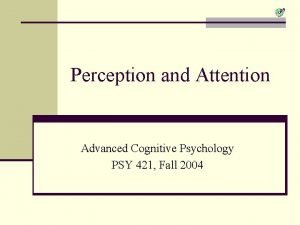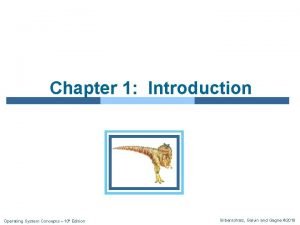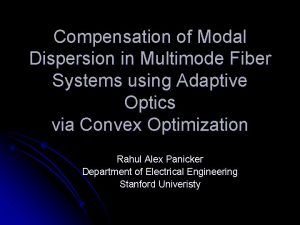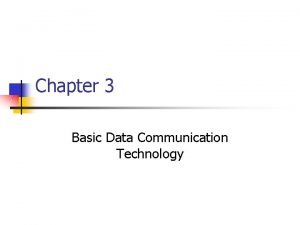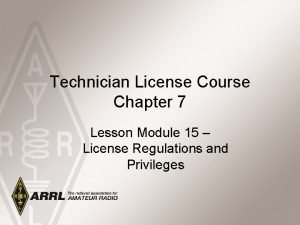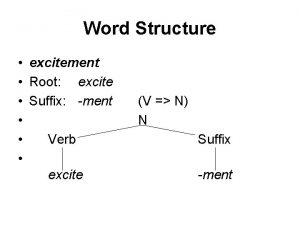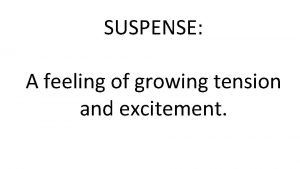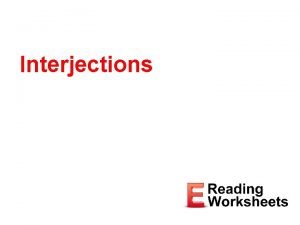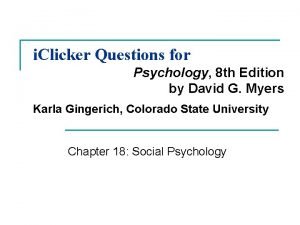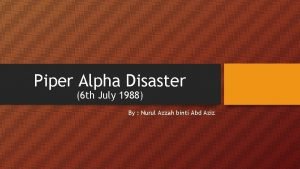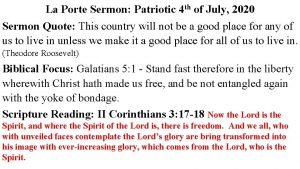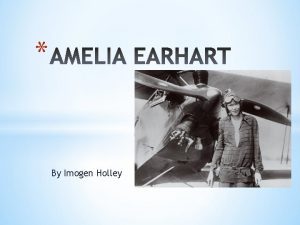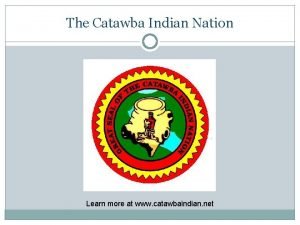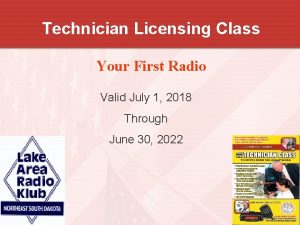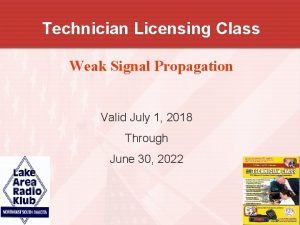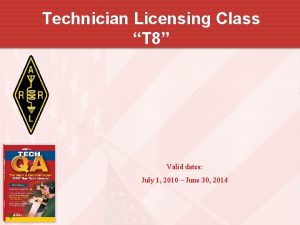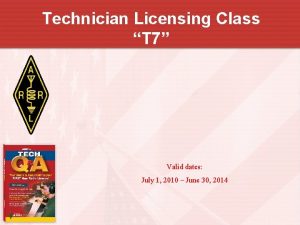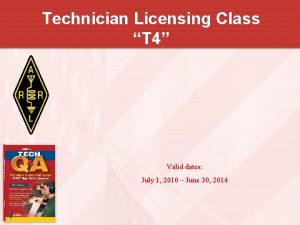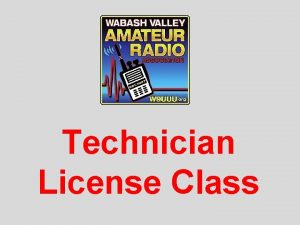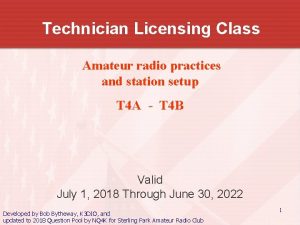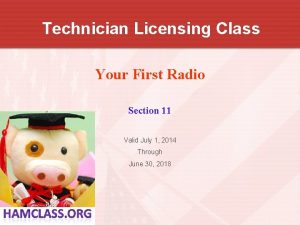Technician Licensing Class MultiMode Radio Excitement Valid July

















































- Slides: 49

Technician Licensing Class Multi-Mode Radio Excitement Valid July 1, 2018 Through June 30, 2022 1

Amateur Radio Technician Class Element 2 Course Presentation Ø ELEMENT 2 SUB-ELEMENTS (Groupings) • • • About Ham Radio Call Signs Control Mind the Rules Tech Frequencies Your First Radio Going Solo Repeaters Emergency! Weak Signal Propagation 2

Amateur Radio Technician Class Element 2 Course Presentation Ø ELEMENT 2 SUB-ELEMENTS (Groupings) • Talk to Outer Space! • Your Computer Goes Ham Digital! Ø Multi-Mode Radio Excitement • Run Some Interference Protection • Electrons – Go With the Flow! • It’s the Law, per Mr. Ohm! • Go Picture These! • Antennas • Feed Me With Some Good Coax! • Safety First! 3

Multi-Mode Radio Excitement • A transceiver is a unit combining the functions of a transmitter and receiver. T 7 A 02 4

Multi-Mode Radio Excitement • SSB (single sideband) is the voice mode most often used for long-distance (weak signal) contacts on the VHF and UHF bands. T 8 A 03 5

Multi-Mode Radio Excitement • The primary advantage of single sideband over FM for voice transmissions is SSB signals have narrower bandwidth. T 8 A 07 6

Multi-Mode Radio Excitement • The SSB/CW-FM switch on a VHF power amplifier sets the amplifier for properation in the selected mode. T 7 A 09 • Single sideband (SSB) is a form of amplitude modulation. T 8 A 01 7

Multi-Mode Radio Excitement • Upper sideband (USB) is normally used for 10 meter HF, VHF and UHF single-sideband communications. as our communications mode. T 8 A 06 • Modulation describes combining speech with an RF carrier signal. T 7 A 08 Amplitude-modulated signal 8

Multi-Mode Radio Excitement • 3 k. Hz is the approximate bandwidth of a single sideband voice signal. T 8 A 08 9

Multi-Mode Radio Excitement • 2400 Hz is an appropriate receive filter bandwidth to select in order to minimize noise and interference for SSB reception. T 4 B 09 10

Multi-Mode Radio Excitement • The use of SSB phone is permitted in at least some portion of all the bands above 50 MHz. • The receiver RIT or clarifier controls could be used if the voice pitch of a single-sideband signal seems too high or low. • “RIT” means Receiver Incremental Tuning. T 2 B 13 T 4 B 06 T 4 B 07 11

Multi-Mode Radio Excitement • The name of a circuit that generates a signal of a desired frequency is called an oscillator. T 7 A 05 • Of FM, SSB, CW and Slow-scan TV CW is the emission that has the narrowest bandwidth. 12 T 8 A 05

Multi-Mode Radio Excitement • 150 Hz is the approximate maximum bandwidth required to transmit a CW signal. T 8 A 11 • 500 Hz is an appropriate receive filter bandwidth to select in order to minimize noise and interference for CW reception. T 4 B 10 13

Multi-Mode Radio Excitement • The advantage of having multiple receive bandwidth choices on a multimode transceiver is that it permits noise or interference reduction by selecting a bandwidth matching the mode. T 4 B 08 14

Multi-Mode Radio Excitement • Sensitivity is the term that describes the ability of a receiver to detect the presence of a signal. T 7 A 01 15

Multi-Mode Radio Excitement • A mixer is used to convert a radio signal from one frequency to another. T 7 A 03 Station Signal C at 455 k. Hz Signal A at 800 k. Hz (or at 1200 k. Hz) Intermediate Frequency Local Oscillator Signal B at 1255 k. Hz (or at 1655 k. Hz) 16

Multi-Mode Radio Excitement • The term that describes the ability of a receiver to discriminate between multiple signals is called selectivity. T 7 A 04 17

Multi-Mode Radio Excitement • The function of automatic gain control or AGC is to keep received audio relatively constant. T 4 B 11 • The RF preamplifier is installed between the antenna and the receiver. T 7 A 11 18

Multi-Mode Radio Excitement • A transverter converts the RF input and output of a transceiver to another band. T 7 A 06 • DMR (Digital Mobile Radio) is a technique for timemultiplexing two digital voice signals on a single 12. 5 k. Hz repeater channel. T 8 D 07 19

Multi-Mode Radio Excitement • A DMR repeater “talk group” is a way for groups of users to share a channel at different times without being heard by other users on the channel. T 2 B 09 • To join a digital repeater’s “talk group” you must program your radio with the group’s ID or code. T 2 B 07 20

Multi-Mode Radio Excitement • Broadband-Hamnet (also referred to as high-speed multimedia network) is an amateur-radio-based data network using commercial Wi-Fi gear with modified firmware. T 8 D 12 21

Element 2 Technician Class Question Pool Multi-Mode Radio Excitement Valid July 1, 2018 Through June 30, 2022 22

T 7 A 02 What is a transceiver? A. A type of antenna switch B. A unit combining the functions of a transmitter and receiver C. A component in a repeater which filters out unwanted interference D. A type of antenna matching network 23

T 8 A 03 Which type of voice mode is most often used for long-distance (weak signal) contacts on the VHF and UHF bands ? A. B. C. D. FM DRM SSB PM 24

T 8 A 07 What is an advantage of single sideband (SSB) over FM for voice transmissions? A. B. C. D. SSB signals are easier to tune SSB signals are less susceptible to interference SSB signals have narrower bandwidth All of these choices are correct 25

T 7 A 09 What is the function of the SSB/CW-FM switch on a VHF power amplifier? A. Change the mode of the transmitted signal B. Set the amplifier for properation in the selected mode C. Change the frequency range of the amplifier to operate in the proper portion of the band D. Reduce the received signal noise 26

T 8 A 01 Which of the following is a form of amplitude modulation? A. B. C. D. Spread-spectrum Packet radio Single sideband Phase shift keying 27

T 8 A 06 Which sideband is normally used for 10 meter HF, VHF and UHF single-sideband communications? A. B. C. D. Upper sideband Lower sideband Suppressed sideband Inverted sideband 28

T 7 A 08 Which of the following describes combining speech with an RF carrier signal? A. B. C. D. Impedance matching Oscillation Modulation Low-pass filtering 29

T 8 A 08 What is the approximate bandwidth of a single sideband voice signal? A. B. C. D. 1 k. Hz 3 k. Hz 6 k. Hz 15 k. Hz 30

T 4 B 09 Which of the following is an appropriate receive filter bandwidth to select in order to minimize noise and interference for SSB reception? A. B. C. D. 500 Hz 1000 Hz 2400 Hz 5000 Hz 31

T 2 B 13 Where may SSB phone be used in amateur bands above 50 MHz? A. Only in sub-bands allocated to General class or higher licensees B. Only on repeaters C. In at least some portion of all these bands D. On any band as long as power is limited to 25 watts 32

T 4 B 06 Which of the following controls could be used if the voice pitch of a single-sideband signal seems too high or low? A. B. C. D. The AGC or limiter The bandwidth selection The tone squelch The receiver RIT or clarifier 33

T 4 B 07 What does the term "RIT" mean? A. B. C. D. Receiver Input Tone Receiver Incremental Tuning Rectifier Inverter Test Remote Input Transmitter 34

T 7 A 05 What is the name of a circuit that generates a signal of a desired frequency? A. B. C. D. Reactance modulator Product detector Low-pass filter Oscillator 35

T 8 A 05 Which of the following types of emission has the narrowest bandwidth? A. B. C. D. FM voice SSB voice CW Slow-scan TV 36

T 8 A 11 What is the approximate maximum bandwidth required to transmit a CW signal? A. B. C. D. 2. 4 k. Hz 150 Hz 1000 Hz 15 k. Hz 37

T 4 B 10 Which of the following is an appropriate receive filter bandwidth to select in order to minimize noise and interference for CW reception? A. B. C. D. 500 Hz 1000 Hz 2400 Hz 5000 Hz 38

T 4 B 08 What is the advantage of having multiple receive bandwidth choices on a multimode transceiver? A. Permits monitoring several modes at once B. Permits noise or interference reduction by selecting a bandwidth matching the mode C. Increases the number of frequencies that can be stored in memory D. Increases the amount of offset between receive and transmit frequencies 39

T 7 A 01 Which term describes the ability of a receiver to detect the presence of a signal? A. B. C. D. Linearity Sensitivity Selectivity Total Harmonic Distortion 40

T 7 A 03 Which of the following is used to convert a radio signal from one frequency to another? A. B. C. D. Phase splitter Mixer Inverter Amplifier 41

T 7 A 04 Which term describes the ability of a receiver to discriminate between multiple signals? A. B. C. D. Discrimination ratio Sensitivity Selectivity Harmonic Distortion 42

T 4 B 11 What is the function of automatic gain control or AGC? A. B. C. D. To keep received audio relatively constant To protect an antenna from lightning To eliminate RF on the station cabling asymmetric goniometer control used for antenna matching 43

T 7 A 11 Where is an RF preamplifier installed? A. Between the antenna and the receiver B. At the output of the transmitter’s power amplifier C. Between transmitter and antenna tuner D. At the receiver’s audio output 44

T 7 A 06 What device converts the RF input and output of a transceiver to another band? A. B. C. D. High-pass filter Low-pass filter Transverter Phase converter 45

T 8 D 07 Which of the following best describes DMR (Digital Mobile Radio)? A. A technique for time-multiplexing two digital voice signals on a single 12. 5 k. Hz repeater channel B. An automatic position tracking mode for FM mobiles communicating through repeaters C. An automatic computer logging technique for hands -off logging when communicating while operating a vehicle D. A digital technique for transmitting on two repeater inputs simultaneously for automatic error correction 46

T 2 B 09 What is a “talk group” on a DMR digital repeater? A. A group of operators sharing common interests B. A way for groups of users to share a channel at different times without being heard by other users on the channel C. A protocol that increases the signal-to-noise ratio when multiple repeaters are linked together D. A net that meets at a particular time 47

T 2 B 07 How can you join a digital repeater’s “talk group”? A. Register your radio with the local FCC office B. Join the repeater owner’s club C. Program your radio with the group’s ID or code D. Sign your call after the courtesy tone 48

T 8 D 12 Which of the following best describes Broadband-Hamnet(TM), also referred to as a high-speed multi-media network? A. An amateur-radio-based data network using commercial Wi-Fi gear with modified firmware B. A wide-bandwidth digital voice mode employing DRM protocols C. A satellite communications network using modified commercial satellite TV hardware D. An internet linking protocol used to network repeaters 49
 Gephi multimode network projection
Gephi multimode network projection Multimode theory of attention
Multimode theory of attention Multimode operation in os
Multimode operation in os Multimode fiber modal dispersion
Multimode fiber modal dispersion Sebutkan karakteristik multimode graded index
Sebutkan karakteristik multimode graded index All multimode modems are not created equal
All multimode modems are not created equal Technician class privileges
Technician class privileges Trunking vs conventional radio system
Trunking vs conventional radio system Show don't tell
Show don't tell Excite suffix
Excite suffix Tension or excitement
Tension or excitement Show don't tell excitement
Show don't tell excitement Interjection of excitement
Interjection of excitement Excitement similes
Excitement similes Ironic essay examples
Ironic essay examples Phys 250 ubc
Phys 250 ubc Bart complied with his friends
Bart complied with his friends Harris burdick missing in venice
Harris burdick missing in venice Uninvited guests harris burdick
Uninvited guests harris burdick July 1-4 1863
July 1-4 1863 Gcc july 2020
Gcc july 2020 Astronomy picture of the day 11 july 2001
Astronomy picture of the day 11 july 2001 2001 july 15
2001 july 15 2003 july 17
2003 july 17 July 30 2009 nasa
July 30 2009 nasa Sources nso frenchhowell neill mit technology...
Sources nso frenchhowell neill mit technology... May 1775
May 1775 I am silver and exact i have no preconceptions
I am silver and exact i have no preconceptions Hurrah for the fourth of july cartoon
Hurrah for the fourth of july cartoon Poppies in july poem
Poppies in july poem Gdje se rodio nikola tesla
Gdje se rodio nikola tesla Ctdssmap payment schedule july 2021
Ctdssmap payment schedule july 2021 July 1969
July 1969 6th july 1988
6th july 1988 Monday 13th july
Monday 13th july On july 18 2001 a train carrying hazardous chemicals
On july 18 2001 a train carrying hazardous chemicals July 4 sermon
July 4 sermon June too soon july stand by
June too soon july stand by July 2 1937 amelia earhart
July 2 1937 amelia earhart June 22 to july 22
June 22 to july 22 July 12 1776
July 12 1776 Recognizing imagery
Recognizing imagery Super saturday tribal bingo july 4
Super saturday tribal bingo july 4 January february march april june july
January february march april june july July 14 1789
July 14 1789 Malaga in july
Malaga in july Leaf yeast experiment
Leaf yeast experiment July 26 1953
July 26 1953 July 16 1776
July 16 1776 Mbitr radio class
Mbitr radio class

